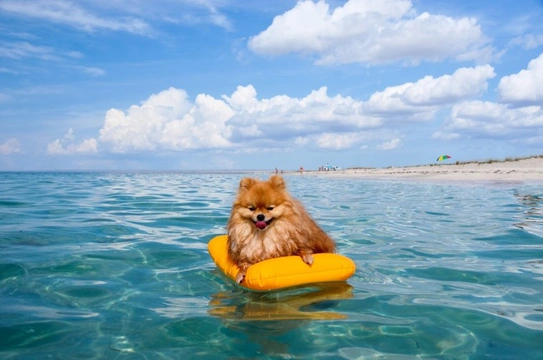
Can Pomeranians swim?
The Pomeranian is a tiny but very fluffy little dog that falls into the Kennel Club’s toy dog group, but they’re also dogs of the spitz type, which means they have plenty of close relatives with working heritage and are rather more robust than they might look at first glance.
Perhaps the most defining feature of the Pomeranian is their coat, which is very dense and thick and comprised of various layers, including a fluffy undercoat that can be incredibly hard to part right down to the skin as there’s so much of it. This helps to give the dog the appearance of bulk and makes them look a little larger than they really are.
This is also a brachycephalic breed, which means one with a shorter than normal muzzle, which is apparent when dogs of the breed are viewed side-on in profile. Their faces are not completely flat, however, like some of the other well-known brachycephalic breeds, which means that they are less likely to suffer from health problems associated with being brachycephalic.
If you’re beginning to research the Pomeranian breed with a view to buying one yourself, you’ve probably noticed that they’re quite expensive compared to other small dog breeds, with the current average asking price for Kennel Club registered Pomeranians being in the region of £1,500.
However, price aside, there is a lot to learn before you choose a Pomeranian as a pet, and even for those who already own a dog of the breed, there is one question that crops up for every Pom owner or enthusiast at some point; can Pomeranians swim?
This article will provide the answer, and some further information on Pomeranians and swimming. Read on to learn more.
Can Pomeranians swim?
The answer to this question isn’t entirely black and white. In an emergency, most Pomeranians would certainly be able to swim for a few minutes until rescued, which is not the case for all dog breeds; specifically, many that share the Pomeranian’s trait of being brachycephalic.
However, as we mentioned earlier, Pomeranians aren’t as flat faced as many breeds, which means the impact this has on them is less too. Very flat-faced dogs cannot keep their noses out of the water in order to breathe when swimming, and many such breeds are also unbalanced weight-wise with disproportionately heavy heads and necks, which makes them sink.
Pomeranians tend to have only moderately short noses and they’re not heavily built or heavy-headed dogs, which means that most Pomeranians can swim passably well, but there are always exceptions, and very flat-faced dogs of the breed may not be able to swim at all.
Additionally, Pomeranians won’t tend to have great stamina for swimming, as they’re small and reasonably delicate dogs with short, fine legs, and so will tire easily in the water.
Does the Pomeranian coat cause problems swimming?
The Pomeranian coat is hugely dense and heavy, and this in itself could potentially cause problems for swimming Poms. Their coats are, however, designed to offer protection against the elements and to repel water to an extent, but this effect is only short-term when immersed.
This means that when the Pomeranian coat becomes waterlogged it will weigh the dog down, making them have to work harder to stay afloat and meaning that the time they’ll be able to swim safely and comfortably for may be reduced.
Do Pomeranians like to swim?
This is another question with no broad answer that applies to all dogs of the breed. Pomeranians that struggle to swim due to the shortness of their muzzle (and of course removing from the equation any dogs of the breed that cannot swim safely at all) will not enjoy the experience; neither will dogs of the breed that have had a bad experience swimming in the past, such as unexpectedly falling into a pool, or swimming when the water was too cold, of if they found the experience stressful.
Some dogs simply don’t like water full stop and won’t even be keen to go for a walk in the rain, so if that is true for your dog, they’re highly unlikely to like swimming either!
However, some Pomeranians are very comfortable in the water and actively enjoy swimming, and so every dog should be introduced to swimming, assessed for ability and comfort, and considered as individuals to answer the question of whether or not they like to swim, and how safe it is for them to do so.
Is swimming good exercise for a Pomeranian?
If your Pomeranian turns out to be a reasonably good swimmer and actively enjoys swimming (which some dogs of the breed very much do) and there is a safe, clean water source that is of the right temperature that you can take them to, swimming is good exercise for a Pomeranian.
It is full-body exercise that is low impact and also can be quite tiring, meaning that your dog won’t be able to swim for as long as they might walk for, and may be quite worn out afterwards too.



